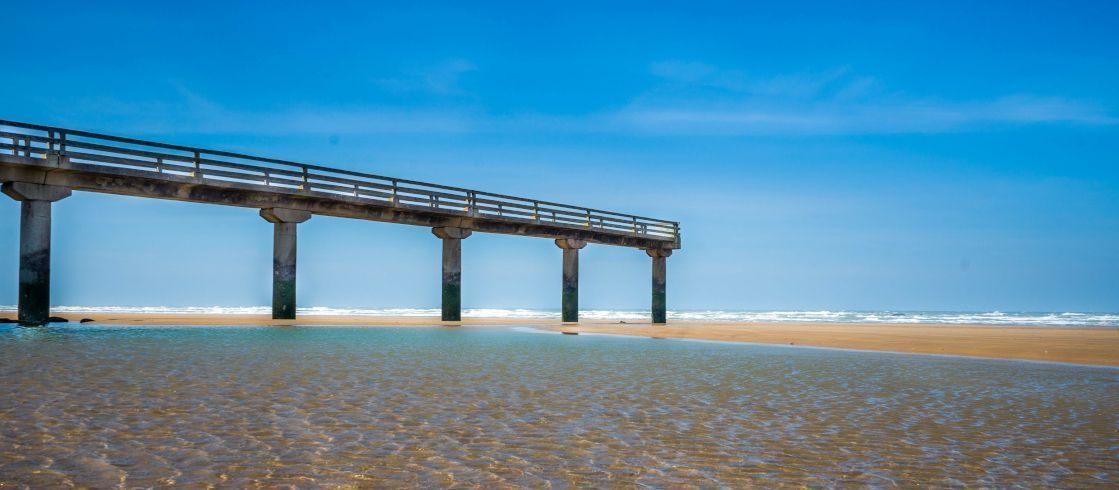To paint in the open air, to grasp the colours of the time passing by, to capture on canvas the moods of the sky, the reflections of water, the rays of the sun and to represent nature with naturalness, this was the principle of the Impressionists. Normandy inspired them and will impress you... Follow the guide.
Climb to Dieppe Castle Museum

Gauguin, Pissarro and Boudin as well as the English artist Turner adored the port of Dieppe with its vibrant energy which they portrayed in their paintings. Today one of the most popular pastimes in the town is to indulge in mussels and chips and the freshest seafood served on the terraces of the many cafés by the docks. So too is a visit to the imposing castle-museum where the impressionist movement is very well represented. From its lofty perch, the castle offers glorious panoramic views over the town and sea.
Admire the sunrise in Le Havre
The light over the Bay of Seine, at sunrise and sunset, is renowned for its striking radiance. Having spent his childhood in Le Havre, the artist Claude Monet was so moved by it that he painted his most famous work, a view of the port of Le Havre. Named Impression, Rising Sun, it gave the Impressionist movement its name. Today Le Havre is a UNESCO World Heritage Site thanks to its modern architecture, but it remains resolutely turned towards the sea. At the Museum of Modern Art André Malraux (MuMa) you’ll discover one of the most beautiful collections of Impressionist works.
Meditating against the cliffs of Etretat
The Porte d’Aval, a rocky arch in the ocean flanked by its majestic Needle is known the world over. These natural sculptures of the spectacular Alabaster coast fascinated Claude Monet as much as the cathedral of Rouen. To enjoy the best viewpoint, climb to the top of the cliff known as the Cap d’Amont, from this great height, where you’ll discover the authentic little Chapelle Notre-Dame de la Garde, the vista is magnificent.
Take a walk on the beach of Trouville
Though ladies no longer wear crinoline and gentlemen don’t dress up in suits and cravats, the beach at Trouville, one of the most beautiful in France, has echoes of the past with its famous 19th century boardwalk, bathing cabins and multicoloured umbrellas. Boudin, Monet, Caillebotte and several other painters captured on canvas many enchanting scenes of lunch on the sand. At low tide, take a stroll from Honfleur to Deauville along the Côte Fleurie, the breeze and the exercise will certainly whet your appetite.
Being in the painting in Honfleur

Just 150 years ago, Honfleur was a charming small port city where the Impressionists were inspired to set up their easels. Parisians and tourists today love to wander around the famous Vieux Basin and up and down the alleys of the picturesque Sainte-Catherine district. On the heights, the former Saint-Siméon inn, a refuge for impressionist painters, is now La Ferme Saint-Siméon, a 5* member of Relais & Châteaux, a gastronomic and refined halt as much as a pilgrimage.
Eating mussels in Barfleur
In the small fishing port of Cotentin, ranked among the most beautiful villages in France, you definitely shouldn’t miss the opportunity to enjoy a generous pot of scrumptious mussels. Blondes de Barfleur, wild mussels from the east coast of the Channel, are the local specialty. You’re sure to love the wonderful landscape, beaches and ever-changing skies whose details were immortalised in the watercolours of the post-Impressionist artist Paul Signac.
Climb to the Varangeville Marine Cemetery

Appearing as if levitating between the sky and the sea, perched on a cliff with breath-taking views over the bay of Dieppe, Varangeville-sur-Mer marine cemetery has long lured painters, musicians and writers. Around the small church decorated with a stained-glass window by cubist artist George Braque who is buried here, are thought-provoking tombs, softly framed by the lush green meadows which contrast beautifully with the white cliffs of the coast and the deep blue of the ocean, it’s a sumptuous landscape.
Caen Museum of Fine Arts
Many visit Caen for its famous Peace Memorial whilst also touring the D-Day landing beaches. The city also has a wonderful Museum of Fine Arts housed in a castle built by the William the Conqueror. Here the Impressionists as well as delicate English watercolours feature prominently.
Follow the guide in Fécamp

The Manet family, Edouard and his sister-in-law and model Berthe Morisot, one of the rare Impressionist women, cherished the small seaside resort of Fécamp, with its baths and casino. You too will love to wander here with the new app Fécamp Discovery, though it’s only in French at the moment, it’s great fun for young and old.
Feel Impressionism in Giverny
Giverny is the "so beautiful countryside" of Claude Monet, here you’ll discover a charming village, and the artist’s house and garden, you’ll experience the scenes that inspired the master of the Impressionists. It was at Giverny that he painted his series Haystacks, Poplars and Water Lilies, creating more than 250 oil paintings vibrant with colour and light. Whatever the time of day and no matter how many people are there, you can’t help but feel emotional as you stand on the famous little wooden bridge overlooking the celebrated pool of water lilies.
Take the view in front of the cathedral of Rouen

They painted the port, the sailboats on the Seine, the alleys and the working-class neighbourhoods born of the industrial revolution. Like a giant open-air studio with an infinite source of inspiration, Rouen was the beloved city of the Impressionists. Pissarro, Gauguin and Sisley painted the Rouen Cathedral. Monet spent many months focused on it, painting a series of impressions, capturing the slightest atmospheric variation at every hour of the day. 28 images of the facade have passed into posterity. Choose your favourite... and discover this masterpiece of Gothic art.
Go further: - Discover the impressionist adventures - Prepare your trip to Normandy

By Pascale Filliâtre
Journalist-traveller. I often voyage to the end of the world to explore what France offers... just next door. [email protected]








